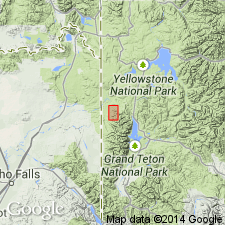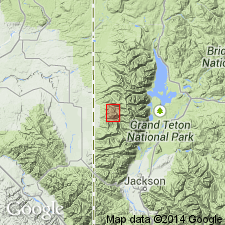
- Usage in publication:
-
- Hominy Peak Formation*
- Modifications:
-
- Revised
- AAPG geologic province:
-
- Yellowstone province
- Snake River basin
Summary:
Underlies a newly named unit, the Pliocene Conant Creek Tuff, in the Teton Range and nearby areas in northwestern WY in the Yellowstone province, and northeastern ID in the Snake River basin. Is assigned an Eocene age.
Source: GNU records (USGS DDS-6; Denver GNULEX).

- Usage in publication:
-
- Hominy Peak Formation*
- Modifications:
-
- Original reference
- Dominant lithology:
-
- Tuff
- Conglomerate
- Claystone
- AAPG geologic province:
-
- Yellowstone province
Summary:
Pg. 3-31, pls. Hominy Peak Formation of Absaroka Volcanic Supergroup. Exposed at north end and on west flank of Teton Range, as well as along south boundary of Yellowstone National Park, northwestern Wyoming. Called "late basic breccia" by Hague and others (USGS Yellowstone folio, 1896; USGS Mon. 32, 1899) and "early basic breccia" by Hague (atlas to accomp. USGS Mon. 32, 1904), Love and others (Wyoming geol. map, 1955) and Love (Teton County geol. map, 1956). Consists of vari-colored volcaniclastic conglomerates, tuffs, quartzite conglomerates, andesite flows and breccia. Includes large blocks of gold-bearing Precambrian quartzites and Paleozoic rocks. Maximum thickness about 2,000 feet (610 m). Unconformably overlies Pinyon Conglomerate or older rocks; unconformably underlies Conant Creek Tuff (at type section) or Huckleberry Ridge Tuff; intruded by late Eocene dacite porphyry of Birch Hills (fission-track age 40.5 +/-2.6 Ma, citing L.L. Love and others, 1976, GSA Bull., v. 87, no. 10, p. 1455-1462). Correlates with Aycross Formation (type area), part of Wagon Bed Formation (unit 3 of Van Houten, 1964, USGS Bull. 1164), strata at Kisinger Lakes leaf locality (called Tepee Trail Formation by Rohrer, IN MacGinitie, 1974, California Univ. Pubs. Geol. Sci., v. 108), and upper part of Wilkins Peak or lower part of Laney Members of Green River Formation in southwestern Wyoming. Fossilifeorus (Kisinger Lakes pollen flora horizon). Age is middle Eocene. Report includes geologic map, measured section, correlation diagram, fossil list and plates.
Type section: exposures 0.5 mi south of Hominy Peak, on southeast-facing escarpment of Hominy Ridge, northwest margin of Conant basin, in SE/4 sec. 16 and northern part sec. 21, T. 47 N., R. 117 W., [approx. Lat. 44 deg. 01 min. 54 sec. N., Long. 110 deg. 53 min. 54 sec. W., Hominy Peak 7.5-min quadrangle], Teton Co., [Jedediah Wilderness Area, Targhee National Forest], northwestern WY.
Named from Hominy Peak, on which a Forest Service lookout station was formerly located at VABM triangulation station 8362 [see Grassy Lake Reservoir quadrangle map, 1956 ed.].
[Additional locality information from USGS historical topographic map collection TopoView, accessed September 2, 2020.]
Source: Publication; US geologic names lexicon (USGS Bull. 1564, p. 75-76).
For more information, please contact Nancy Stamm, Geologic Names Committee Secretary.
Asterisk (*) indicates published by U.S. Geological Survey authors.
"No current usage" (†) implies that a name has been abandoned or has fallen into disuse. Former usage and, if known, replacement name given in parentheses ( ).
Slash (/) indicates name conflicts with nomenclatural guidelines (CSN, 1933; ACSN, 1961, 1970; NACSN, 1983, 2005, 2021). May be explained within brackets ([ ]).

